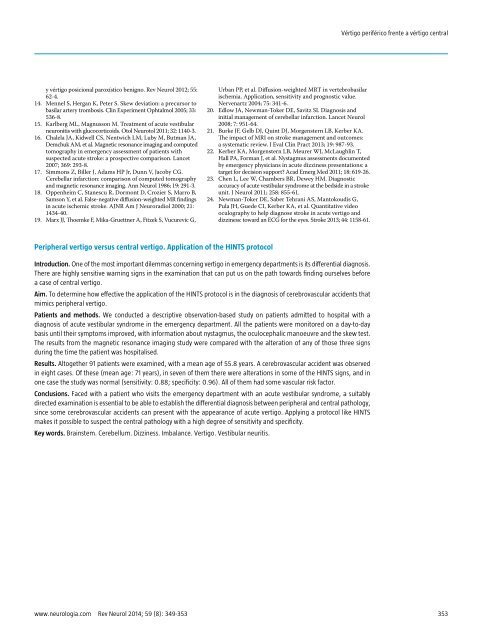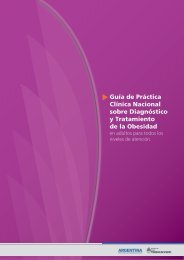bm080349
bm080349
bm080349
You also want an ePaper? Increase the reach of your titles
YUMPU automatically turns print PDFs into web optimized ePapers that Google loves.
Vértigo periférico frente a vértigo central<br />
y vértigo posicional paroxístico benigno. Rev Neurol 2012; 55:<br />
62-4.<br />
14. Mennel S, Hergan K, Peter S. Skew deviation: a precursor to<br />
basilar artery trombosis. Clin Experiment Ophtalmol 2005; 33:<br />
536-8.<br />
15. Karlberg ML, Magnusson M. Treatment of acute vestibular<br />
neuronitis with glucocorticoids. Otol Neurotol 2011; 32: 1140-3.<br />
16. Chalela JA, Kidwell CS, Nentwich LM, Luby M, Butman JA,<br />
Demchuk AM, et al. Magnetic resonance imaging and computed<br />
tomography in emergency assessment of patients with<br />
suspected acute stroke: a prospective comparison. Lancet<br />
2007; 369: 293-8.<br />
17. Simmons Z, Biller J, Adams HP Jr, Dunn V, Jacoby CG.<br />
Cerebellar infarction: comparison of computed tomography<br />
and magnetic resonance imaging. Ann Neurol 1986; 19: 291-3.<br />
18. Oppenheim C, Stanescu R, Dormont D, Crozier S, Marro B,<br />
Samson Y, et al. False-negative diffusion-weighted MR findings<br />
in acute ischemic stroke. AJNR Am J Neuroradiol 2000; 21:<br />
1434-40.<br />
19. Marx JJ, Thoemke F, Mika-Gruettner A, Fitzek S, Vucurevic G,<br />
Urban PP, et al. Diffusion-weighted MRT in vertebrobasilar<br />
ischemia. Application, sensitivity and prognostic value.<br />
Nervenartz 2004; 75: 341-6.<br />
20. Edlow JA, Newman-Toker DE, Savitz SI. Diagnosis and<br />
initial management of cerebellar infarction. Lancet Neurol<br />
2008; 7: 951-64.<br />
21. Burke JF, Gelb DJ, Quint DJ, Morgenstern LB, Kerber KA.<br />
The impact of MRI on stroke management and outcomes:<br />
a systematic review. J Eval Clin Pract 2013; 19: 987-93.<br />
22. Kerber KA, Morgenstern LB, Meurer WJ, McLaughlin T,<br />
Hall PA, Forman J, et al. Nystagmus assessments documented<br />
by emergency physicians in acute dizziness presentations: a<br />
target for decision support? Acad Emerg Med 2011; 18: 619-26.<br />
23. Chen L, Lee W, Chambers BR, Dewey HM. Diagnostic<br />
accuracy of acute vestibular syndrome at the bedside in a stroke<br />
unit. J Neurol 2011; 258: 855-61.<br />
24. Newman-Toker DE, Saber Tehrani AS, Mantokoudis G,<br />
Pula JH, Guede CI, Kerber KA, et al. Quantitative video<br />
oculography to help diagnose stroke in acute vertigo and<br />
dizziness: toward an ECG for the eyes. Stroke 2013; 44: 1158-61.<br />
Peripheral vertigo versus central vertigo. Application of the HINTS protocol<br />
Introduction. One of the most important dilemmas concerning vertigo in emergency departments is its differential diagnosis.<br />
There are highly sensitive warning signs in the examination that can put us on the path towards finding ourselves before<br />
a case of central vertigo.<br />
Aim. To determine how effective the application of the HINTS protocol is in the diagnosis of cerebrovascular accidents that<br />
mimics peripheral vertigo.<br />
Patients and methods. We conducted a descriptive observation-based study on patients admitted to hospital with a<br />
diagnosis of acute vestibular syndrome in the emergency department. All the patients were monitored on a day-to-day<br />
basis until their symptoms improved, with information about nystagmus, the oculocephalic manoeuvre and the skew test.<br />
The results from the magnetic resonance imaging study were compared with the alteration of any of those three signs<br />
during the time the patient was hospitalised.<br />
Results. Altogether 91 patients were examined, with a mean age of 55.8 years. A cerebrovascular accident was observed<br />
in eight cases. Of these (mean age: 71 years), in seven of them there were alterations in some of the HINTS signs, and in<br />
one case the study was normal (sensitivity: 0.88; specificity: 0.96). All of them had some vascular risk factor.<br />
Conclusions. Faced with a patient who visits the emergency department with an acute vestibular syndrome, a suitably<br />
directed examination is essential to be able to establish the differential diagnosis between peripheral and central pathology,<br />
since some cerebrovascular accidents can present with the appearance of acute vertigo. Applying a protocol like HINTS<br />
makes it possible to suspect the central pathology with a high degree of sensitivity and specificity.<br />
Key words. Brainstem. Cerebellum. Dizziness. Imbalance. Vertigo. Vestibular neuritis.<br />
www.neurologia.com Rev Neurol 2014; 59 (8): 349-353<br />
353








